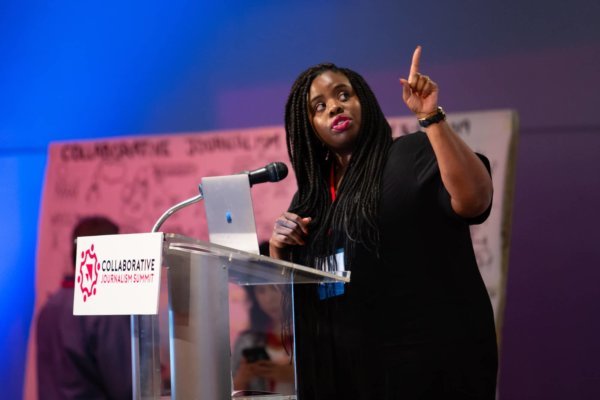Journalism collaboratives around the U.S. highlighted during ‘Ten Talks’ at Collaborative Journalism Summit
By Elizabeth Llorente
Collaborative journalism is gaining strength around the United States, with more local news organizations pooling resources with one another and with community groups to fill the void left by understaffed – or altogether shuttered – newsrooms.
In a presentation titled: “Ten Talks: A Lightning Round of 10-Minute Presentations about Collaborative Projects around the U.S.” at the Collaborative Journalism Summit in Philadelphia on May 17, journalists from around the country described their projects.
Those presentations are summarized below; you can also see all the presenters’ slides here and photos here.
Stories of Atlantic City

From left, Evan Sanchez, Alexandra Nunzi and Mike Rispoli present about Stories of Atlantic City at the 2019 Collaborative Journalism Summit. Photo by Leslie Barbaro.
In New Jersey, the Stories of Atlantic City collaborative effort brought together media professionals and members of the local community. Community members selected stories they thought should be told, and the media outlets agreed to tell them. The partnership included Free Press, the Center for Cooperative Media at Montclair State University, Stockton University, The Leadership Studio, Authentic City Partners and five media organizations.
A major goal of the effort, said Evan Sanchez, co-founder of the Authentic City Partners, was to provide coverage of the city that went beyond the simplistic view of it as a home to casinos.
“When people think of Atlantic City, they think of just one story – casinos,” Sanchez said. “Many of us felt that our stories weren’t being amplified.”
Alexandra Nunzi, co-founder of The Leadership Studio, said that with her established ties in the city, she was able to be a bridge between residents and the media.
“People who know me know my team, and they know they can trust us,” she said, adding that bringing residents into the fold produces stories about “the forgotten folks who’ve been raising their families” and contributing, despite having “every card stacked against them.”
Detroit Journalism Cooperative
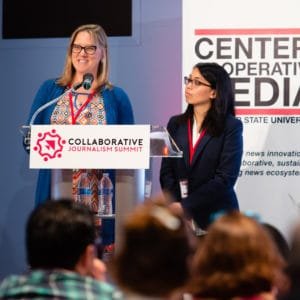
From left, Sandra Svoboda and Zosette Guir present at the 2019 Collaborative Journalism Summit. Photo by Leslie Barbaro.
The Detroit Journalism Cooperative, which is funded by the Knight and Ford foundations, launched in 2014 and has brought together journalists from TV, radio and print. The collaborative includes New Michigan Media, a consortium of the state’s minority and ethnic news outlets.
Pooling resources paved the way for coverage of the 2018 gubernatorial race that gave Michiganders unprecedented comprehensive, multimedia stories about the candidates, said Sandra Svoboda, the Great Lakes Now program director for Detroit Public Television, a member of the collaborative.
The cooperative brought six journalists from the partner news outlets together to do hourlong interviews with six of the seven Democratic and Republican candidates (one declined) over two days in the Detroit Public Television studio.
“They covered Flint’s recovery, how they would fix the state’s roads, immigration,” said Zosette Guir, managing producer of One Detroit.
They sorted through six hours of footage, and with input from the reporters, produced more than 80 videos in a few days for the partner news outlets to use.
“For each candidate’s page, you got a full transcription of what they said,” Svoboda said. “It became about getting material to the audience in a way they could digest it.”
Since Parkland
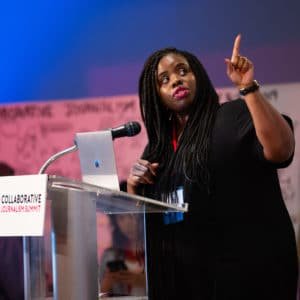
Akoto Ofori-Atta from The Trace talks about ‘Since Parkland’ at the 2019 Collaborative Journalism Summit. Photo by Leslie Barbaro.
The Trace, a Brooklyn-based nonprofit that covers gun violence, wanted to do something impactful and moving to mark the anniversary of the 2018 mass killing at the Marjory Stoneman Douglas High School in Parkland, Florida.
In a partnership with The Miami Herald, and with the help of journalism educators, The Trace worked with 214 teenage reporters from around the country to write 100-word profiles of youths who were fatally shot.
The result was “Since Parkland,” which covered “12 months, 1,200 American kids shot and killed.”
On the Feb. 14 anniversary of the Parkland school shooting, The Miami Herald published the project on its website and carried it in its print edition.
“We decided that we would hire student journalists,” said Akoto Ofori-Atta, The Trace’s managing editor, who added that their voice and perspective was crucial, given that it is their generation that increasingly is experiencing gun violence. It was important, Ofori-Atta said, to “have details of the lives these students led that go beyond crime-blotter style” stories.
“We had Trace mentors on hand to help with big reporting challenges,” she said, “but most of the challenges were worked out by the teens themselves.”
“We told them to find victims that had been overlooked,” she added. The project “told hundreds of stories of victims, many of whom were black and brown and whose stories [previously] did not get told.”
Chi.Vote

Fernando Diaz and Asraa Mustafa present at the 2019 Collaborative Journalism Summit. Photo by Leslie Barbaro.
When it became clear that Chicago was in the midst of a political turning point last year, — with Mayor Rahm Emanuel deciding against running for a third term and a rare crowded field of 14 candidates vying to succeed him — several news outlets decided to join forces to empower voters.
“We thought, ‘What do we do?’ This was the most consequential election in Chicago,” said Fernando Diaz, editor and publisher of The Chicago Reporter, one of 10 news organizations in the collaborative. “This was a historic election.”
“Chicago voters are not used to having that many options,” he said. “It was an unusual election in the sheer volume of candidates we had to cover. I spoke to another [journalist] who said they were having trouble deciding how to cover it.”
They created Chi.Vote, a collaborative voting guide that featured campaign stories, data and live election results. The new election crew included more than 40 reporters and 11 editors.
They determined that they had to target many Chicago residents who were first-time voters, and discovered that many of them did not know what ward they lived in. So they developed a custom ward-lookup tool, an ask-us-anything-about-the-election feature, a tracker on various issues and each candidate’s position on them, and a database. They also worked with Univision, which translated the election guide, to reach Spanish-speaking voters.
A data scraper that the collaborative developed enabled it to receive and report live election results, which spared it the high cost of using the Associated Press’s live results, Diaz said.
“We never imagined that The Chicago Reporter would be able to pull live election results without paying for them,” he said.
Granite State News Collaborative

Melanie Plenda presents at the 2019 Collaborative Journalism Summit. Photo by Leslie Barbaro.
New Hampshire veteran journalist Melanie Plenda told the conference attendees that as someone “with the heart of a muckraker, I rolled my eyes” when she made her foray into the world of journalism partnerships.
“It means working with an outlet you’ve been trying to scoop forever,” said Plenda, who is the project manager for the Granite State News Collaborative.
But it didn’t take long for Plenda to see the value of working as a team with others driven by a determination to pull back the curtain of community problems and press political leaders and others in power to address them. The collaborative adopted the Solutions Journalism Network’s philosophy of deeply reporting on community issues and presenting ways to resolve them.
“Solutions journalism is just good, solid investigative journalism,” she said, adding that they decided to tackle the subject of addiction and behavioral health. New Hampshire in recent years has ranked among the top five states in the U.S. with the highest rates of opioid-related deaths.
The project includes conferences that bring together people who have used the state’s mental health services and journalists who are working on the issues.
With shared resources, she said, “you start to uncover all these stories you would not have uncovered otherwise.”
Since January, they have done more than 40 stories, video and audio pieces.
“Collaboratives tend to attract journalism’s true believers, who do it because they love it…because it’s our way of giving back,” Plenda said. “There is truly nothing in my career that has felt this good.”
Colorado Media Project
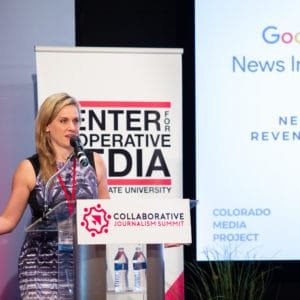
Lori Gliha presents at the 2019 Collaborative Journalism Summit. Photo by Leslie Barbaro.
Colorado’s two longtime major newspapers, The Denver Post and The Rocky Mountain News, had more than 500 reporters covering the state 10 years ago. The Rocky Mountain News was shut down, and the Denver Post has dramatically slashed its staff.
Community newspapers also were disappearing. The local reporting crisis gave birth to the Colorado Media Project in 2018.
“The old way of gathering and disseminating news had changed forever,” said Lori Jane Gliha, an investigative correspondent for Rocky Mountain Public Media. “We had to think outside the box.”
The project has conducted a survey of more than 2,000 Colorado residents to learn about their preference for getting news, the subjects that are of the most interest, and how willing they are to pay for access to the news.
Colorado journalists also have been interviewed, and the project has conducted analyses of business models for statewide news platforms. The collaborative is also behind the construction of a new building, expected to be open in 2020, that will house dozens of news organizations and be accessible to the community.
Resolve Philadelphia and The Reentry Project

Cassie Haynes presents at the 2019 Collaborative Journalism Summit. Photo by Leslie Barbaro.
In Pennsylvania, more than a dozen newsrooms got together to look at the obstacles that people leaving prison face when trying to return to society.
Their work, called The Reentry Project, prompted businesses to re-evaluate hiring practices regarding people with criminal records, and the Department of Prisons to hire interpreters for the hearing-impaired.
The input of formerly incarcerated people was crucial, said Cassie Haynes, co-executive director of Resolve Philadelphia.
“We know that those closest to the problem are also those closest to the solution,” Haynes said.
California Dream
And finally, Adriene Hill, the senior editor for the California Dream collaboration, a statewide nonprofit media venture, said that they started out by asking the audience of a call-in show what they wanted to have covered.
“Everyone wanted to talk about housing,” Hill said, “so we looked at [about a dozen] seniors in California and what they could tell us about challenges the state faces as this population gets older.”
Hill said that through one of the collaborative’s partners, the nonprofit CALmatters – which itself has more than 100 media partners around the state — California Dream has seen many of its stories picked up by other news outlets. California Dream also has gotten many of its radio stories to air nationally.
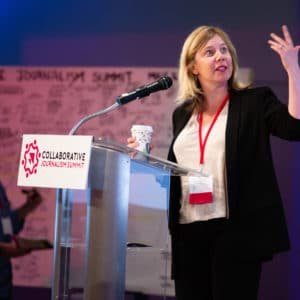
Adriene Hill presents at the 2019 Collaborative Journalism Summit. Photo by Leslie Barbaro.
“It speaks to the quality of the work we’re doing,” Hill said.
The collaborative also provided volunteer reporters and producers to media outlets that were stretched thin covering the Northern California blaze last year that killed 85 people and destroyed 15,000 homes.
Now, 38 organizations are working together on a police misconduct project, Hill said. They are sharing information requests with one another that they have submitted to government agencies, as well as the responses they receive.
“This is something that only could happen,” Hill noted about the transparency among competitors, “because we learned to trust each other in this process.”
Elizabeth Llorente is a freelance journalist and public speaker specializing in news media. Contact her at [email protected].
About the Center for Cooperative Media: The Center is a grant-funded program of the School of Communication and Media at Montclair State University. Its mission is to grow and strengthen local journalism, and in doing so serve New Jersey residents. The Center is supported with funding from the John S. and James L. Knight Foundation, the Geraldine R. Dodge Foundation, Democracy Fund, the New Jersey Local News Lab Fund of the Community Foundation of New Jersey and the Abrams Foundation. For more information, visit CenterforCooperativeMedia.org.

